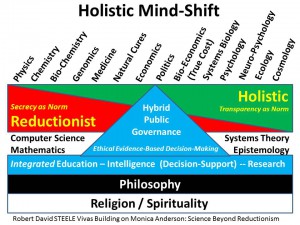
Jean Lievens: Video (1:39:09) Science Beyond Reductionism – “Model Free Methods” as a Holistic Shift
Crowd-Sourcing, Culture, Design, Economics/True Cost, Education, Governance, Knowledge, P2P / Panarchy, Politics, Resilience, Transparency
Monica Anderson is CEO of Syntience Inc. and originator of a theory for learning called “Artificial Intuition” that may allow us to create computer based systems that can understand the meaning of language in the form of text. Here she discusses the ongoing paradigm shift – the “Holistic Shift” – which started in the life sciences and is spreading to the remaining disciplines. Model Free Methods (also known as Holistic Methods) are an increasingly common approach used on “the remaining hard problems”, including problems in the domain of “AI” – Problems that require intelligence. She illustrates this using a Model Free approach to the NetFlix Challenge. Her website provides some background information.

Koko: Mushroom-Based Packaging Replacing Plastics or Styrofoam
Design, Economics/True Cost, Innovation
 Ecovative’s environmentally responsible products can replace materials ranging from petroleum based expanded plastics (like Styrofoam™) to particle board made using carcinogenic formaldehyde. Our materials are 100% renewable, and primarily made from agricultural byproducts. These low-embodied energy materials can be home composted when they’re no longer needed.
Ecovative’s environmentally responsible products can replace materials ranging from petroleum based expanded plastics (like Styrofoam™) to particle board made using carcinogenic formaldehyde. Our materials are 100% renewable, and primarily made from agricultural byproducts. These low-embodied energy materials can be home composted when they’re no longer needed.
Many of the materials and chemicals that are commonly used come from non-renewable fossil fuel resources. However, cheaply extracted petroleum and gas supplies are a thing of the past. Our landfills are filling up, and even when we recycle things properly, it requires a lot of energy only to yield a lower grade material. The future lies in using rapid renewables that can also be returned to the earth at the end of their use.
Can mushrooms help us get rid of Styrofoam?
The New Yorker, May 20, 2013
Robin Good: Blekko Groups Online Search Curation on the Fly
Advanced Cyber/IO, Crowd-Sourcing, Design, Innovation
Curates by Source and Category
Blecko / Environmental Degradation
Blecko / Other Atrocities Human
SchwartzReport: In Govenrment We Do Not Trust….
Corruption, Culture, Design, Government, Ineptitude, IO Impotency, PoliticsHere is the abstract of a research paper, that is one of the first things I ever saw that seriously considered the E-government trend, and how it is going to impact citizens. It was published two years ago and, recently a reader sent it to me, and I read it again. I want you to notice how little has changed in the three year! s since it was published. Why is that, do you suppose?
Also note this odd lacuna. There is not discussion of voting, only communications. With our existing technology it is possible to develop e-voting in such a way that each citizen could vote. You wouldn't have to have polling booths, you wouldn't have to mail things, and you wouldn't have to go anywhere. It could be done from any computer, a pad, or a smartphone. To secure it you could use social security numbers, a pre-set-up ID, and a password.
We do billions of financial transactions each day on less security. By comparison this would be 50 state websites, whose Federal totals were simultaneously sent to a Federal website. Everyone eligible could vote in a single day. It would all be completely transparent to the media and the citizens.
It would bypass voter suppression, hanging chads, and all the rest of the schemes. And it would produce a radically different Congress and serve as the counterweight to Citizens' United.
Ask yourself: Why don't we have such a system?
Misplaced Trust? Exploring the Structure of the E-Government-Citizen Trust Relationship
FORREST V. MORGESON III, DAVID VANAMBURG and SUNIL MITHAS – Journal of Public Adminstation Research and Theory
Abstract
A growing body of research focuses on the relationship between e-government, the relatively new mode of citizen-to-government contact founded in information and communications technologies, and citizen trust in government. For many, including both academics and policy makers, e-government is seen as a potentially transformational medium, a mode of contact that could dramatically improve citizen perceptions of government service delivery and possibly reverse the long-running decline in citizen trust in government. To date, however, the literature has left significant gaps in our understanding of the e-government-citizen trust relationship. This study intends to fill some of these gaps. Using a cross-sectional sample of 787 end users of US federal government services, data from the American Customer Satisfaction Index study, and structural equation modeling statistical techniques, this study explores the structure of the e-government-citizen trust relationship. Included in the! model are factors influencing the decision to adopt e-government, as well as prior expectations, overall satisfaction, and outcomes including both confidence in the particular agency experienced and trust in the federal government overall. The findings suggest that although e-government may help improve citizens’ confidence in the future performance of the agency experienced, it does not yet lead to greater satisfaction with an agency interaction nor does it correlate with greater generalized trust in the federal government overall. Explanations for these findings, including an assessment of the potential of e-government to help rebuild trust in government in the future, are offered.
Jean Lievens: Stigmergic Collaboration: The Evolution of Group Work
Crowd-Sourcing, Culture, Design, Education, Innovation, Knowledge, P2P / Panarchy
Collaboration depends on communication, and content depends on combination of social negotiation and creative energy.
Stigmergic Collaboration: The Evolution of Group Work
M/C Journal, May 2006
Introduction
1The steady rise of Wikipedia.org and the Open Source software movement has been one of the big surprises of the 21st century, threatening stalwarts such as Microsoft and Britannica, while simultaneously offering insights into the emergence of large-scale peer production and the growth of gift economies.
2Many questions arise when confronted with the streamlined efficacy and apparent lack of organisation and motivation of these new global enterprises, not least “how does this work?” Stigmergic collaboration provides a hypothesis as to how the collaborative process could jump from being untenable with numbers above 25 people, towards becoming a new driver in global society with numbers well over 25,000.
Complete post with references below the line.
Continue reading “Jean Lievens: Stigmergic Collaboration: The Evolution of Group Work”
Robin Good: Automated Topic-Specific Online Curation Tool
Crowd-Sourcing, Culture, Design, Innovation, Knowledge, P2P / Panarchy, Software Kurator is a web service which allows you to easily customize one or more visual magazines that automatically aggregate the hashtags, lists, Twitter users, Facebook pages and RSS feeds you specify.
Kurator is a web service which allows you to easily customize one or more visual magazines that automatically aggregate the hashtags, lists, Twitter users, Facebook pages and RSS feeds you specify.
Specifically, you can aggregate from the following sources:
- Twitter User
- Twitter List
- Twitter Keywords
- Twitter Hastags
- Twitter Mentions
- Twitter Top Followers
- Facebook Page
- Facebook Keywords
- RSS Feed
You can also filter and specify specific keywords that you want to be included/excluded.
Kurators offers the ability to title each stream, and to customize somewhat the look of the final magazine by providing a few templates and layouts and access to the controls to adjust the font style, size and color.
The final stream can be published as a web page on Kurator or exported directly to WordPress as a “page”.
Continue reading “Robin Good: Automated Topic-Specific Online Curation Tool”

